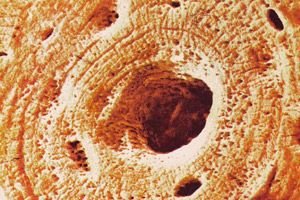
All iLive content is medically reviewed or fact checked to ensure as much factual accuracy as possible.
We have strict sourcing guidelines and only link to reputable media sites, academic research institutions and, whenever possible, medically peer reviewed studies. Note that the numbers in parentheses ([1], [2], etc.) are clickable links to these studies.
If you feel that any of our content is inaccurate, out-of-date, or otherwise questionable, please select it and press Ctrl + Enter.
Material found to help grow new bone tissue
Last reviewed: 02.07.2025
 ">
">American specialists were able to grow new bone tissue on a damaged skull of a rodent. Most scientists around the world have already called this experiment a technical revolutionary step in the field of surgical bone reconstruction.
The latest technological method, developed by specialists from the universities of Northwestern and Chicago in Illinois, should help solve the problem of restoring bone tissue in the body, as well as the nearby vascular network. At the same time, the use of transplants will become optional.
A new biological material that can “grow” bone tissue gives fairly quick and high-quality results.
"The results of the experiments are truly amazing. If our idea can be realized, then we can forget about difficult, painful and unimproved bone grafting operations (the so-called "grafting")," Guillermo Amir is sure. Amir is a doctor of medical and biological engineering, representing the McCormick faculty of Northwestern University - he was directly involved in the development of the method.
Damage and abnormalities of the cranium are difficult to correct. In most cases, surgeons have to use parts of the patient's own bone tissue - for example, fragments of the pelvic bone or ribs. Such treatment is very traumatic and unsafe, especially if the bone defect has a large area.
A group of scientists led by Professor Amir was able to grow bone tissue on top of an artificial hydrogel scaffold using a catalyzing protein growth factor.
In order to avoid having to introduce a stimulating protein from the outside, specialists were able to achieve a certain modification of cells for the body to independently produce a protein substance. Having covered the bone damage with a framework, scientists placed cells producing a protein growth factor in this place. Soon, the affected area was filled with a young network of vessels and dense natural bone tissue.
During the study, autologous cell structures were used that could not provoke rejection. BMP9 protein was chosen as a stimulator protein.
The bone augmentation framework had the following composition: citric acid and polymer nanocomposite. The nanocomposite is initially a liquid that transforms into a gel under the influence of human body temperature.
During the surgical intervention, the surgeon distributes the biological material over the site of the bone defect: the mass immediately hardens, forming an elastic “patch” on the bone, which subsequently degenerates into normal healthy bone tissue.
Scientists are confident that this innovation will soon be widely used in the field of surgery and bone reconstruction. Bone defects can be eliminated in patients after mechanical injuries to the skull, after resection of tumor processes, to correct congenital anomalies in the development of the skull, etc. Although researchers advise not to rush to conclusions yet, because the experiments were conducted only on rodents.

 [
[